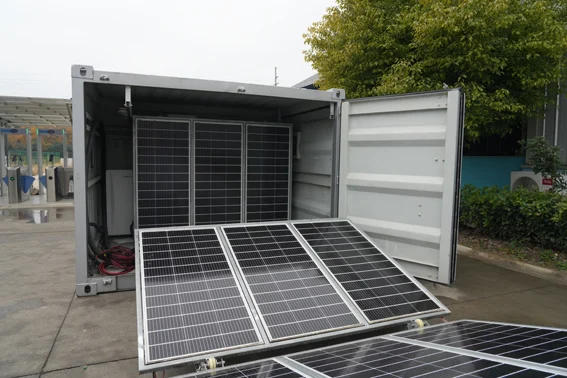The 20ft foldable solar PV container is a technological leap in renewable energy technology, combining portability with scale-up power generation. For rapid deployment in remote, temporary, or disaster-stricken areas, such containers are transforming the access to clean energy for industries and communities. With modular design, energy density, and smart integration technologies, the 20ft foldable solar PV container is not just a power solution but also a gateway to energy democratization.
1. Capacity and Design: Energy Maximization in Little Space
A standard 20ft collapsible solar PV container typically integrates photovoltaic panels, lithium-ion batteries, inverters, and energy management systems into a compact, portable unit. The capacity of such systems is 40–80 kWh, depending on the configuration, with certain high-efficiency models having as much as 100 kWh6. The key breakthroughs behind this capacity are:
Modular Solar Panels: Foldable structures, such as triangular subpanels with hinge systems, allow panels to deploy out of a compact 20ft container into a considerable solar array, achieving energy capture without sacrificing portability89.
High-Density Batteries: Lithium-ion batteries with more than 200 Wh/kg energy densities realize efficient storage in tight space. New patents, e.g., those by Hubei Tianheng Solar, incorporate intelligent thermal management to optimize battery life and security3.
Smart Energy Management: Intelligent systems monitor energy production and consumption in real time, adjusting panel angles through automated actuators to maximize solar absorption—a function included in Ningxia Zhongying Longxiang’s foldable PV patent9.
With these technologies, a 20ft container can power small towns (50–100 houses) or industrial parks for days, even off-grid.
2. Breaking Barriers: Applications Beyond Traditional Power Grids
The solar PV 20ft foldable container is best in scenarios where traditional energy infrastructure fails:
Disaster Response: After earthquakes or hurricanes, these containers are airlifted and available within hours. Boxpower’s equipment, for example, has provided emergency power to Puerto Rico after hurricanes, supplying 60 kWh/day to critical installations26.
Military and Remote Operations: The U.S. Department of Defense uses collapsible containers to supply energy to forward bases with less consumption of diesel generators. Their rapid deployment facilitates the “Energy Resilience” goals of modern militaries6.
Agricultural Innovation: Kenya’s solar containers utilize photovoltaic-powered pumps to irrigate farms, offering 60% savings in diesel costs and access to water during droughts12.
Foldability of the containers also makes them ideal for city use. Tianjin Solar’s rooftop systems in Shanghai, for instance, use foldable setups to meet space constraints, generating 50 kWh per day for office buildings8.
3. Technological Synergy: How Patents Are Shaping the Future
Emerging patents indicate innovations that maximize 20ft container performance:
Dynamic Angle Adjustment: Hubei Tianheng’s patented sliding mounts allow panels to shift to 180°, harvesting energy seasonally3.
Hybrid Energy Systems: Blending lithium-ion batteries and vanadium flow batteries (as in European pilot projects) takes storage to 120 kWh, ideal for multi-day rainy weather6.
AI-Optimized Efficiency: Jinyang Solar’s collapsible connectors use machine learning to predict weather conditions, adjusting panel arrangements automatically to predict shading or storms10.
These technologies place the 20ft container into a “smart grid in a box” configuration, easy to run independently and connect into microgrids.
4. Market Trends: Why 20ft Containers Are the New Frontier
The global market for foldable solar containers is projected to achieve a 20.5% CAGR and reach $1.2 billion by 203026. The growth drivers are:
Policy Incentives: The U.S. Inflation Reduction Act (IRA) offers 30% tax credits for solar storage installations, and the EU’s Green Deal emphasizes mobile renewable systems26.
Cost Savings: The cost of solar panels has decreased by 80% since 2010, and 20ft containers are now economically viable for villages and SMEs6.
Carbon Neutrality Targets: Foldable containers are being utilized by companies like IKEA and Amazon to power warehouses, fulfilling net-zero targets1.
Interestingly, the market share in the 40–80 kWh category is 52% because of need for systems of medium capacity that fulfill capacity needs and mobility requirements6.
5. Challenges and the Way Forward
Underneath their potential, 20ft collapsible boxes face challenges:
Thermal Management: Battery performance can be compromised by temperatures at extremes. Phase-change material (PCMs) solutions are being tested to level out internal conditions3.
Recycling Complexity: Lithium-ion disposal remains a challenge, though firms like BYD are exploring closed-loop recycling for recovery of 95% of material6.
Standardization Gaps: Interoperability is inhibited by connector incompatibility and protocols. The IEC is creating global standards to harmonize interfaces6.
In the future, the combination of hydrogen fuel cells and solar self-healing coatings can unlock capacities well beyond 150 kWh, making these containers into standalone power centers for smart cities and off-grid industries.
Conclusion: The 20ft Container as a Catalyst for Energy Equity
The foldable solar PV container in 20ft form is not only a technological marvel—it’s a tool for bridging energy divides. In delivering clean, scalable energy to the world’s most remote communities, it empowers communities, reduces carbon footprints, and shifts global energy landscapes. As patents expand and costs decrease, this technology will be nothing less than a pillar of the renewable revolution, showing that great things can be packed into small, foldable packages.

